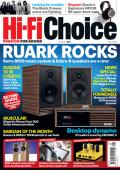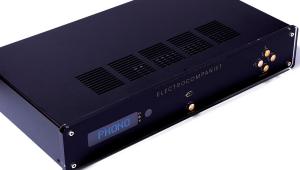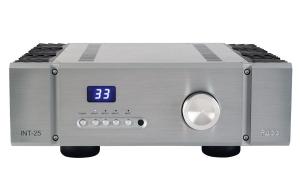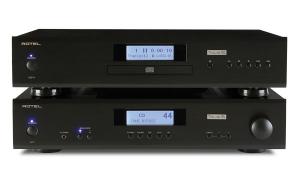Cambridge Audio AXA35/AXC35

 In the motoring world it is often said that if you want to know what features and gadgets the average family car will be sporting in five years’ time, just take a look at the toys on the Mercedes S-Class of today. The same is true of hi-fi equipment and the concept of trickle-down technology. The idea is simple – a manufacturer blows their budget on something top-end in order to show what they can really achieve, but then aspects developed for those flagship models gradually work their way down to more affordable offerings.
In the motoring world it is often said that if you want to know what features and gadgets the average family car will be sporting in five years’ time, just take a look at the toys on the Mercedes S-Class of today. The same is true of hi-fi equipment and the concept of trickle-down technology. The idea is simple – a manufacturer blows their budget on something top-end in order to show what they can really achieve, but then aspects developed for those flagship models gradually work their way down to more affordable offerings.
The latest manufacturer to highlight this advantage is Cambridge Audio. The company was arguably better known for making premium products in its formative years – such as the groundbreaking CD-1 compact disc player in 1985 – but has more recently become known for its excellent value two-channel audio components and multi-room speaker systems.
That said, a 50th birthday couldn’t be ignored, and last year Cambridge Audio surprised many with the unveiling of its three-strong high-end Edge range with a £3,500 preamp with built-in network audio player and matching £2,500 power amplifier (both reviewed HFC 447) as well as a £4,500 integrated amplifier – each superbly designed, immaculately finished and, by all accounts, pretty spectacular on the sonic front too. Now the brand has returned to the budget end of things, and, although it shares little of the internal technology of its more upmarket brethren, the AX’s smart front panel and level of finish echoes the quality build theme.
The AX series replaces the popular Topaz models and currently consists of a six-strong lineup of two-channel options. First up are the AXA25 and AXA35 stereo amplifiers, retailing at £230 and £300 respectively, accompanied by the matching AXC25 and AXC35 CD players, also £230 and £300. Finally, come the £350 AXR85 and £450 AXR100 stereo receivers.
The AXA35 reviewed as part of the amplifier/CD combo here is a sleek model with a power rating of 2x 35W; 10W up on the cheaper AXA25. In the centre of the front panel is a digital display that carries information about source selection, volume level and other menu items. Connectivity includes four line-level inputs through phono sockets at the rear, plus a fifth via a 3.5mm jack socket on the front. Plugging something into this front panel socket automatically selects this input, although it can be over ridden. However, as its selector button shares that of the A1 input, you cannot select it while something is connected to the front socket, which seems a little odd.
Another peculiarity is that the USB port fitted to the rear only provides power to a connected USB item – it is not actually an audio input. Also at the rear are a set of good-quality loudspeaker binding posts and Cambridge continues its tradition of labelling all its available connections both upside down – so that you can see the input you’re grappling with on the rear panel when looking over the top of unit – as well as the right way up, which all helps to make interconnect and speaker cable connections a doddle.
The AXA35 also comes pre-fitted with a phono stage input for moving-magnet cartridges and given the company’s success with its budget Duo phono stage (HFC 436) it’s a big bonus to have one installed here at the price. Completing the lineup, there’s a front-mounted 6.35mm headphone jack, which – like the phono input and display – does not feature on the cheaper AXA25.
Moving to the AXC35 CD player, this is a perfect visual match for the amplifier. It plays CDs as well as home-burned CD-R/CD-RW discs containing MP3 or WMA files and uses the highly regarded Wolfson Electronics WM8524 DAC chip in its output stage. All of the usual track selection and programming facilities are available and the unit is supplied with a remote control that is nice enough, but not as stylish or solid as controllers partnered with Azur-series models. Stereo analogue RCA outputs are fitted, as is a coaxial digital output – the latter is not found on the more affordable AXC25 player.
Sound quality
With both the AXA35 and AXC35 connected together and feeding Usher’s S-520 standmount placed on Atacama SL-600 stands, I am quickly reminded why Cambridge Audio has such a reputation for good-quality budget designs. The combo serves up a clean and detailed sound with a natural flow. There is a pleasing weight and sense of impact to the performance, which can often be lacking at this price level, and a most commendable sense of cohesion across the frequency range.
At the top end, the pairing offers up highly impressive clarity, with little trace of hardness. The Usher’s tweeter can be unforgiving in this respect, but the AXA35 caresses it delicately and the result is a crisp yet composed delivery through the upper frequencies and the overall presentation is a delight. Although not quite managing the levels of forensic clarity that more expensive setups can muster, the AXA35 and AXC35 combo delivers a good amount of detail.
In spatial terms, the area between the speakers is neatly ordered. The soundstage does not extend much beyond the physical limits of the cabinets laterally, but there is a good sense of depth perspective to the rear. Where the Cambridge pair betrays its budget origins is in terms of projection out into the room. On Afterglow from her eponymous debut CD, singer Harriet is positioned well in the centre of the performance within the plane of the speakers, although I would normally expect to be able to hear the vocal clear of the backing instruments.
That said, however, the tonal palette is pleasingly broad. Donald Harrison’s soprano saxophone on Shadowbrook from his The Power Of Cool album has just the right amount of metallic rasp to sound believable, and the backing and fretless bass are detailed and clean. Once again, the subtle cymbal effects throughout stand out as a result of the top-end clarity served up by the AX pair. These effects are never lost as the performance progresses and have a consistent presence.
At the bottom end, the AXA35 and AXC35 show off another common Cambridge trait. Not only is the bass firm, detailed and blessed with excellent timing, but when things become more dance orientated it laps up a decent beat. Spinning The Divine Comedy’s I’ve Been To A Marvellous Party is an absolute hoot as the Cambridge duo makes a fine job of Neil Hannon’s soft murmurings during the verses, and then hit their stride with the thumping techno beat in the choruses. Give this combo a bangin’ tune and it loves it – pushing it out with confidence and punch.
As the album A Secret History plays on to The Certainty Of Chance track, the AXA35 and AXC35 again prove highly proficient with the initial music and the main vocals. The introductory drum roll rumbles across the soundstage in a confident manner that is usually the preserve of far more expensive components. In addition, percussion is snappy while Hannon’s vocals are emotive and clear within the mix.
However, when it gets to the heavier chorus on this track, I notice a sense of discomfort. This part of the song is a typically grand Divine Comedy work, adding in orchestral elements in addition to the main band. As the section takes flight, it seems to overwhelm the combo, rendering the track a little muddled and introducing a slight sense of compression across the midband. Rather than soaring outwards, the whole performance shrinks in on itself. To get to the bottom of this, I briefly swap the AXA35 for my usual budget integrated, a Yamaha A-S500 (HFC 364), and discover that, it is the amplifier that’s adding this artefact. The Yamaha improves on the dynamic abilities of the performances and is better equipped to separate instruments when things become more crowded within the soundstage. That said, the AXA35 still remains supreme in terms of ultimate top-end clarity and poise; being better able to pick out the finer aspects of the backing instruments.
Finally, the lure of the AXA35’s phono stage is too strong to pass up and so I connect a Pro-Ject Debut III S Audiophile turntable (HFC 437) fitted with the company’s Pick-IT 25A MM cartridge and am delighted to hear that Cambridge Audio’s phono stage mastery is present and correct. The AXA35 remains its composed and confident self and also starts to gain a better sense of depth perspective than through the line-level inputs. This is definitely no after-thought inclusion and makes the AXA35 a flexible amp for any budget vinyl system too.
Conclusion
Cambridge Audio’s AXA35 integrated amplifier and AXC35 CD player make a fine budget combo. Individually, the amplifier is no slouch, but the CD player is something of a budget marvel that really doesn’t put a foot wrong in any aspect of its performance. The combo works well together and forms an ideal starting point for anyone seeking an enjoyable and affordable setup. AS
DETAILS
Product: Cambridge Audio AXA35/AXC35
Price: £300/£300
Origin: UK/China
Type: Integrated amplifer/CD player
Weight: 5.6kg/4.3kg
Dimensions: (WxHxD) 430 x 83 x 335mm/ 430 x 75 x 305mm
FEATURES
AXA35
● Quoted power output: 2x 35W (8ohm)
● 5x line-level inputs
● MM phono stage
● 6.35mm headphone socket
AXC35
● CD/CD-R/CD-RW playback
● 1x stereo analogue RCAs; 1x digital coaxial output
 |
Inside this month's issue:
Ruark R610 music system and Sabre-R standmount speakers, PMC twenty.23i Active, floorstanders, English Acoustics Downton preamplifier, Bluesound NODE ICON preamp/streamer, Ortofon Concorde Music Blue MM cartridge and much, much more
|



















































